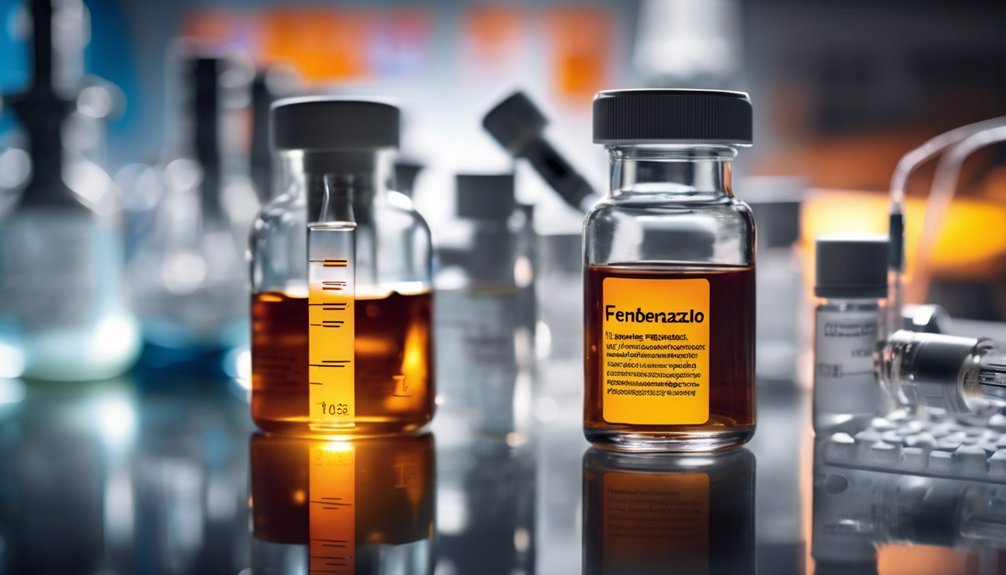You’re likely aware that fenbendazole has limited bioavailability, which hampers its effectiveness. Recent advancements in nanotechnology offer promising solutions to enhance its absorption. By employing nanocarriers like liposomes and polymeric nanoparticles, researchers are aiming to improve solubility and stability. These innovations could transform fenbendazole’s therapeutic application significantly. However, the full extent of their impact on clinical outcomes remains to be seen. What specific advancements are leading the charge in this evolving field?
Key Takeaways
- Nanotechnology enhances fenbendazole solubility and stability, facilitating improved absorption rates in the gastrointestinal tract.
- Liposomal formulations provide controlled release and biocompatibility, optimizing the drug’s therapeutic efficacy.
- Solid lipid nanoparticles increase fenbendazole bioavailability and protect against degradation during delivery.
- Cyclodextrins and surfactants serve as solubility enhancers, improving dissolution rates and systemic circulation.
- Targeted delivery systems enable precise treatment regimens, minimizing side effects and improving patient outcomes.
Understanding Fenbendazole and Its Mechanism of Action

Understanding Fenbendazole’s mechanism of action is crucial for optimizing its therapeutic efficacy. Fenbendazole exhibits its antiparasitic effects primarily by inhibiting microtubule polymerization, disrupting intracellular transport and cellular structure.
Its pharmacokinetics reveal variable absorption rates influenced by factors such as formulation and administration route. You must consider the implications of drug resistance mechanisms that certain parasites may employ, which can significantly diminish fenbendazole’s effectiveness.
For instance, changes in drug targets or enhanced efflux pumps can lead to reduced susceptibility. By comprehensively analyzing these aspects, you can develop strategies to improve fenbendazole’s application in therapeutic settings, ensuring that it remains a viable option against resistant parasitic infections.
Utilizing this knowledge effectively can lead to better patient outcomes.
Challenges of Fenbendazole Bioavailability
While fenbendazole shows promise as an effective antiparasitic agent, its bioavailability poses significant challenges that can hinder therapeutic outcomes.
One major issue is formulation stability; if the drug degrades before it reaches its target, effectiveness diminishes.
Formulation stability is critical; drug degradation before reaching its target can significantly reduce its effectiveness.
You’ll also encounter absorption barriers in the gastrointestinal tract, where fenbendazole’s physicochemical properties can limit its uptake.
Factors like solubility and permeability play crucial roles in determining how much of the drug enters systemic circulation.
These challenges necessitate innovative approaches to enhance bioavailability, ensuring that patients receive the maximum therapeutic benefit.
The Role of Nanotechnology in Drug Delivery
As researchers continue to explore innovative solutions for enhancing drug delivery, nanotechnology has emerged as a transformative approach that can significantly improve the bioavailability of compounds like fenbendazole.
Recent nanotechnology advancements enable the formulation of nanoparticles that enhance solubility and stability, ensuring better absorption in biological systems. By utilizing these advancements, you can achieve targeted delivery of fenbendazole, minimizing systemic side effects while maximizing therapeutic effects.
This precision in targeting allows for more effective treatment regimens, particularly in challenging cases where traditional methods fall short. Through the integration of nanotechnology in drug delivery systems, you’re not only improving the efficacy of fenbendazole but also contributing to a more patient-centric approach in pharmaceuticals, ultimately serving the needs of those requiring effective treatment.
Nanocarriers: A Game Changer for Fenbendazole

Nanocarriers have revolutionized the way fenbendazole is delivered, offering a highly efficient means to enhance its absorption and therapeutic efficacy. By utilizing various nanocarrier types, you can optimize delivery mechanisms tailored to specific needs.
- Liposomes: Provide biocompatibility and controlled release.
- Polymeric nanoparticles: Enable targeted delivery and sustained action.
- Solid lipid nanoparticles: Enhance stability and bioavailability.
- Nanostructured lipid carriers: Combine the benefits of solid and liquid lipids for improved absorption.
- Dendrimers: Offer customizable surface properties for precise drug targeting.
These advancements not only improve fenbendazole’s solubility but also ensure that it reaches its target site effectively. Ultimately, this contributes to better health outcomes for those relying on this treatment.
Enhancing Solubility: Innovative Formulation Strategies
Advancements in nanocarrier technology have paved the way for innovative formulation strategies aimed at enhancing the solubility of fenbendazole.
You’ll encounter formulation challenges, primarily its low aqueous solubility, which limits bioavailability. To overcome this, employing solubility enhancers like cyclodextrins or surfactants can significantly improve dissolution rates.
Formulating fenbendazole with these agents allows for better interaction with water, facilitating absorption. Additionally, utilizing solid dispersions and liposomal formulations can create a more stable environment for the drug, further promoting solubility.
By integrating these strategies, you’ll not only improve fenbendazole’s pharmacokinetic profile but also enhance its therapeutic efficacy.
It’s essential to stay informed about these advances to better serve patients and optimize treatment outcomes.
Lipid-Based Nanoparticles for Improved Absorption
While traditional methods of enhancing fenbendazole absorption have their merits, lipid-based nanoparticles (LNPs) present a compelling alternative due to their unique properties.
These lipid formulations improve bioavailability through precise nanoparticle design, allowing for better encapsulation and delivery of the drug.
Here are some key advantages of using LNPs:
- Enhanced solubility and stability of fenbendazole
- Targeted delivery to specific tissues
- Improved cellular uptake and transport mechanisms
- Reduced side effects through localized action
- Potential for customized release profiles
Polymer-Based Approaches to Fenbendazole Delivery

When considering effective methods for fenbendazole delivery, polymer-based approaches offer significant advantages over traditional formulations. By focusing on optimal polymer selection, you can enhance drug solubility and bioavailability. Techniques such as microencapsulation and hydrogel systems allow for targeted release and improved stability, making them essential for formulation optimization.
| Polymer Type | Advantages | Applications |
|---|---|---|
| Natural Polymers | Biocompatible, biodegradable | Sustained release systems |
| Synthetic Polymers | Tailored properties | Controlled drug delivery |
| Copolymers | Versatile characteristics | Combination therapies |
Solid Lipid Nanoparticles: Benefits and Applications
Solid lipid nanoparticles (SLNs) represent a promising drug delivery system that combines the advantages of liposomes and polymeric nanoparticles.
Solid lipid nanoparticles (SLNs) merge the benefits of liposomes and polymeric nanoparticles, offering an innovative approach to drug delivery.
Their unique structure enhances fenbendazole absorption while ensuring nanoparticle stability.
You’ll find that SLNs offer several benefits, including:
- Improved bioavailability due to enhanced solubility
- Controlled release properties, prolonging the drug’s therapeutic effect
- Biocompatibility, reducing toxicity in biological systems
- Protection of sensitive compounds from degradation
- Versatility in formulation, accommodating various active ingredients
Clinical Trials and Real-World Applications
As research into fenbendazole delivery continues to evolve, clinical trials and real-world applications are essential for validating the effectiveness of solid lipid nanoparticles (SLNs) in enhancing drug absorption.
These trials must assess not only the pharmacokinetics and bioavailability of fenbendazole in SLN formulations but also their safety profiles in diverse patient populations.
Real-world applications can further demonstrate how SLNs improve therapeutic outcomes in clinical settings, especially for patients with limited treatment options.
By collecting data from both controlled environments and everyday medical practice, you’ll establish a clearer understanding of SLNs’ impact on fenbendazole’s efficacy.
This comprehensive approach will ultimately guide healthcare professionals in implementing these advanced formulations, ensuring better service to those in need of effective parasitic treatments.
Future Prospects for Fenbendazole Formulations

The ongoing advancements in solid lipid nanoparticle (SLN) formulations for fenbendazole present exciting opportunities for future applications in both clinical and veterinary medicine.
As you explore these developments, consider how future formulation innovations can enhance therapeutic efficacy and patient compliance.
The potential market impact is substantial, particularly in the following areas:
- Improved bioavailability and absorption rates
- Targeted delivery systems for specific pathogens
- Customizable formulations for diverse patient populations
- Enhanced stability and shelf-life of fenbendazole products
- Integration of nanotechnology with existing therapeutic protocols
Implications for Patient Outcomes and Healthcare
While advancements in fenbendazole formulations promise enhanced absorption and bioavailability, their implications for patient outcomes and healthcare are equally significant. Improved formulations can lead to better therapeutic efficacy, potentially reducing treatment duration and associated costs.
This can enhance healthcare accessibility, particularly for underserved populations, as effective treatments become more affordable and easier to administer. Additionally, patient education becomes crucial; empowering patients with knowledge about these new formulations can foster adherence and optimize outcomes.
Frequently Asked Questions
What Are the Side Effects of Fenbendazole?
When using fenbendazole, you might experience side effects like gastrointestinal upset, lethargy, or neurological symptoms. It’s crucial to monitor for signs of fenbendazole toxicity, ensuring safe and effective usage for those you wish to help.
Can Fenbendazole Be Used for Human Health?
While fenbendazole shows promise in research, its efficacy for human health remains unproven. Human trials could illuminate its potential, but without rigorous testing, its application in medicine shouldn’t be taken lightly. Caution is essential.
How Does Fenbendazole Compare to Other Antiparasitic Drugs?
When comparing fenbendazole to other antiparasitic drugs, you’ll find its efficacy stems from a unique antiparasitic mechanism, effectively disrupting microtubule formation in parasites, offering a promising alternative in treating various parasitic infections.
What Is the Recommended Dosage of Fenbendazole?
You’ll find the recommended dosage of fenbendazole varies, but generally, it’s crucial to follow dosage guidelines and treatment protocols closely to ensure effectiveness while minimizing side effects. Always consult a healthcare professional for the best advice.
Is Fenbendazole Safe for Pets and Livestock?
Fenbendazole’s generally safe for pets and livestock when used correctly. You should always consult a veterinarian to ensure pet safety and livestock health, as dosage and individual health conditions can significantly affect outcomes.
Conclusion
Incorporating nanotechnology into fenbendazole formulations can dramatically enhance its bioavailability and therapeutic effectiveness. For instance, studies show that lipid-based nanoparticles can increase drug absorption by up to 300%. This significant improvement not only optimizes treatment outcomes but also reduces systemic side effects, making fenbendazole a more viable option in both human and veterinary medicine. As research progresses, these innovative strategies promise to redefine patient care, ensuring that effective therapies are more accessible than ever before.




